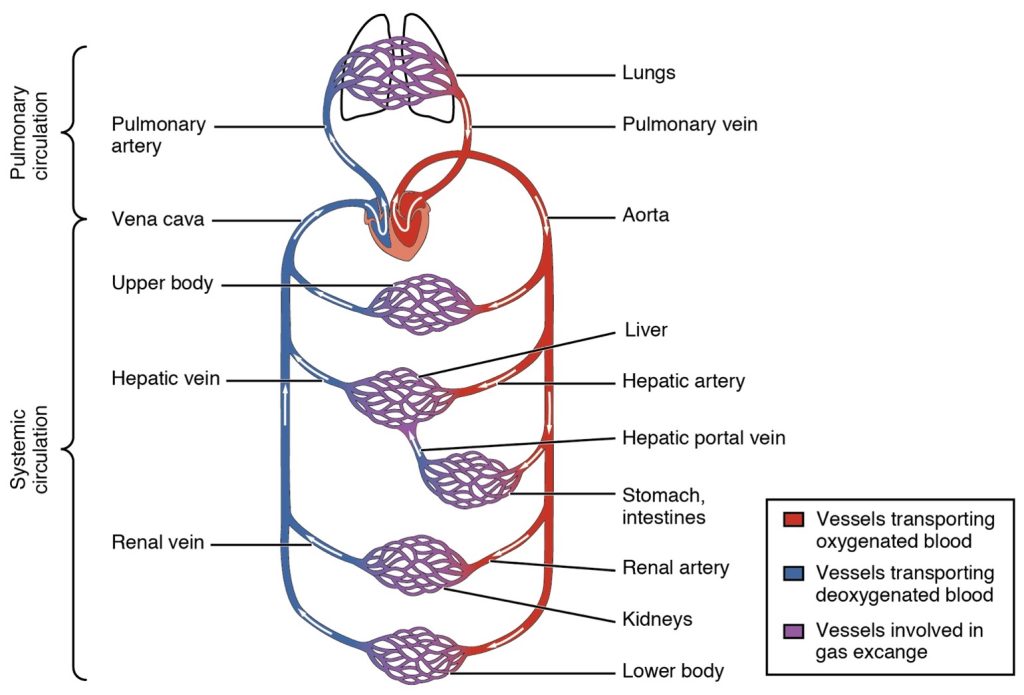41 Functions of the cardiovascular system
Jim Davis
Learning Objectives
After studying this section, you should be able to-
- Describe the major functions of each component of the cardiovascular system (i.e., blood, heart, blood vessels).
The cardiovascular system is comprised of three major components- the blood, heart, and blood vessels. Each of these play a crucial role, allowing the cardiovascular system to be the transportation system of the body. The function of each will be described in more detail below.
Blood
Blood is a connective tissue made up of cellular elements and an extracellular matrix. The cellular elements, or formed elements include red blood cells (RBCs), white blood cells (WBCs), and platelets. The extracellular matrix, called plasma, makes blood unique among connective tissues because it is fluid. This fluid, which is mostly water, contains the formed elements and enables them to circulate throughout the body within the cardiovascular system.
Functions of Blood
The primary function of blood is to deliver oxygen and nutrients to, and remove wastes from, the body’s cells; but that is only the beginning of the story. The specific functions of blood also include defense and maintenance of homeostasis, such as distributing heat where it is needed.
Transportation
Nutrients from the foods you eat are absorbed in the digestive tract. Most of these travel in the bloodstream directly to the liver, where they are processed and released back into the bloodstream for delivery to body cells. Oxygen from the air you breathe diffuses into the blood, which moves from the lungs to the heart, which then pumps it to the rest of the body. Moreover, endocrine glands scattered throughout the body release hormones into the bloodstream, which carries them to distant target cells. Blood also picks up cellular wastes and byproducts, transporting them to various organs for removal. For instance, blood moves carbon dioxide to the lungs for exhalation from the body, and various waste products are transported to the kidneys and liver for excretion from the body in the form of urine or bile.
Defense
Many types of WBCs protect the body from external threats, such as disease-causing bacteria that have entered the bloodstream in a wound. Other WBCs seek out and destroy internal threats, such as cells with mutated DNA that could multiply to become cancerous, or body cells infected with viruses.
When damage to the vessels results in bleeding, a process called hemostasis is initiated. Hemostasis (which will be discussed in more detail later) is when blood platelets and certain proteins dissolved in the plasma interact to create clots that block the ruptured areas of the blood vessels involved. This protects the body from further blood loss.
Maintenance of Homeostasis
Body temperature is regulated via a negative-feedback loop. If you were exercising on a warm day, your rising core body temperature would trigger several homeostatic mechanisms, including increased transport of blood from your core to your body periphery, which is typically cooler. As blood passes through the vessels of the skin, heat would be dissipated to the environment, and the blood returning to your body core would be cooler. In contrast, on a cold day, blood is diverted away from the skin to maintain a warmer body core.
Blood also helps to maintain the chemical balance of the body. Proteins and other compounds in blood act as buffers, which help to regulate the pH of body tissues. Blood also helps to regulate the water content of body cells because it has large proteins that exert osmotic pressure, which resist excessive fluid loss from the blood.
Heart
The heart is a muscular pump that propels blood through the vessels. Its contraction generates the pressure needed to eject blood into the aorta and pulmonary trunk, distributing it throughout the body. At rest, a typical adult heart pumps about 5 liters of blood per minute, increasing to 25 liters or more during maximal exercise.
Blood vessels
Blood is carried through the body via blood vessels. Arteries are blood vessels that carry blood away from the heart, where they branches into ever-smaller vessels. Eventually, the smallest arteries, vessels called arterioles, branch into tiny capillaries, where nutrients and wastes are exchanged. Capillaries come together to form venules, small blood vessels that carry blood to a vein, a larger blood vessel that returns blood to the heart.
Arteries and veins transport blood in two distinct circuits: the systemic circuit and the pulmonary circuit (Figure 40.1). Systemic arteries provide blood rich in oxygen to the body’s tissues. The blood returning to the heart through systemic veins has less oxygen, since much of the oxygen carried by the arteries has been delivered to the cells. Arteries in the systemic circuit carry oxygen-rich blood, while pulmonary arteries carry oxygen-poor blood to the lungs for gas exchange. In contrast, in the pulmonary circuit, arteries carry blood low in oxygen exclusively to the lungs for gas exchange. Pulmonary veins then return freshly oxygenated blood from the lungs to the heart to be pumped back out into systemic circulation.

Adapted from Anatomy & Physiology by Lindsay M. Biga et al, shared under a Creative Commons Attribution-ShareAlike 4.0 International License, chapters 18-20
Connective tissue made up of cellular elements and an extracellular matrix
a sub-compartment of extracellular fluid; the liquid component of blood, containing water, electrolytes, nutrients, hormones, and waste products
A mechanism that works in the opposite direction of the stimulus, and in turn, brings body parameters back to set point
Blood vessels that carry blood away from the heart
Blood vessels that carry blood to the heart
the pathway that transports blood from the left side of the heart to the body, and back to the right side of the heart
the pathway that transports blood from the right side of the heart, to the lungs, and back to the heart

